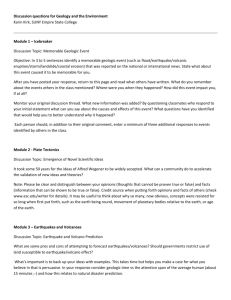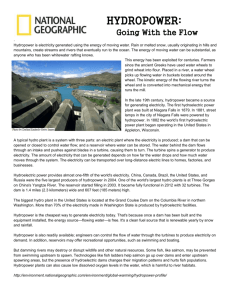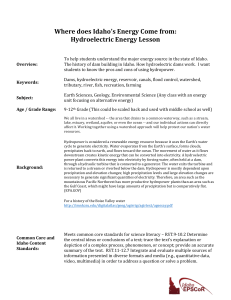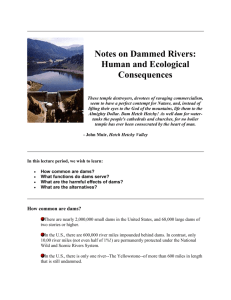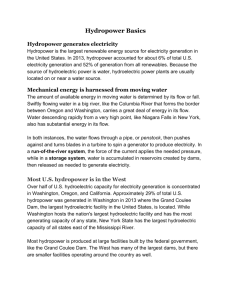Overview - United States Association for Energy Economics
advertisement
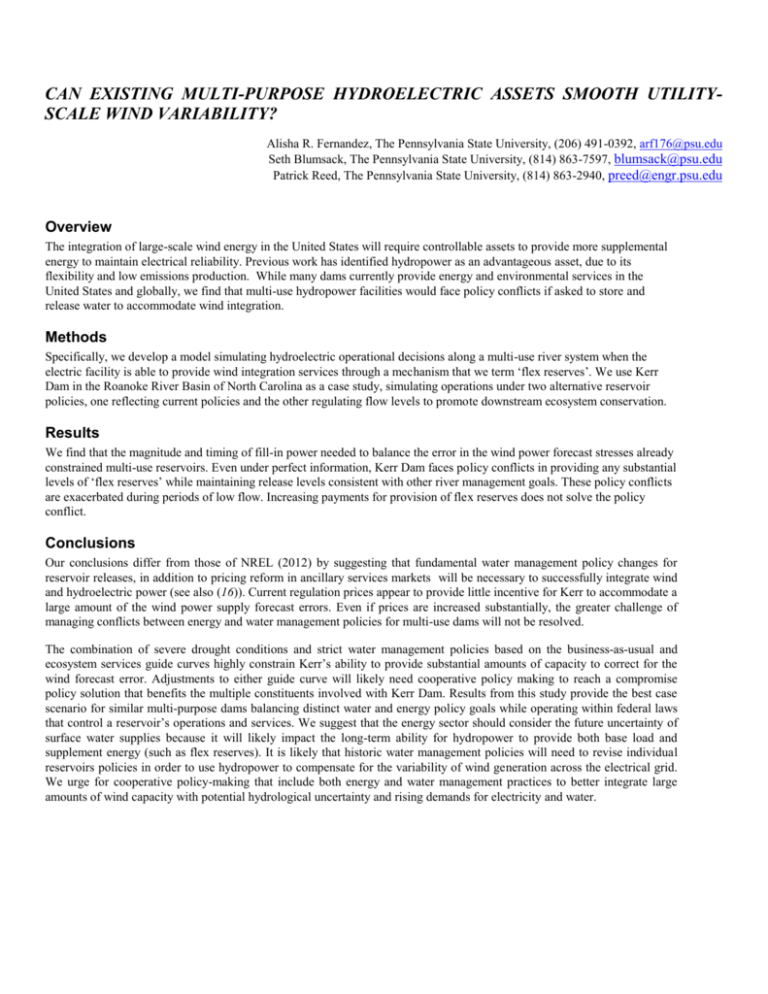
CAN EXISTING MULTI-PURPOSE HYDROELECTRIC ASSETS SMOOTH UTILITYSCALE WIND VARIABILITY? Alisha R. Fernandez, The Pennsylvania State University, (206) 491-0392, arf176@psu.edu Seth Blumsack, The Pennsylvania State University, (814) 863-7597, blumsack@psu.edu Patrick Reed, The Pennsylvania State University, (814) 863-2940, preed@engr.psu.edu Overview The integration of large-scale wind energy in the United States will require controllable assets to provide more supplemental energy to maintain electrical reliability. Previous work has identified hydropower as an advantageous asset, due to its flexibility and low emissions production. While many dams currently provide energy and environmental services in the United States and globally, we find that multi-use hydropower facilities would face policy conflicts if asked to store and release water to accommodate wind integration. Methods Specifically, we develop a model simulating hydroelectric operational decisions along a multi-use river system when the electric facility is able to provide wind integration services through a mechanism that we term ‘flex reserves’. We use Kerr Dam in the Roanoke River Basin of North Carolina as a case study, simulating operations under two alternative reservoir policies, one reflecting current policies and the other regulating flow levels to promote downstream ecosystem conservation. Results We find that the magnitude and timing of fill-in power needed to balance the error in the wind power forecast stresses already constrained multi-use reservoirs. Even under perfect information, Kerr Dam faces policy conflicts in providing any substantial levels of ‘flex reserves’ while maintaining release levels consistent with other river management goals. These policy conflicts are exacerbated during periods of low flow. Increasing payments for provision of flex reserves does not solve the policy conflict. Conclusions Our conclusions differ from those of NREL (2012) by suggesting that fundamental water management policy changes for reservoir releases, in addition to pricing reform in ancillary services markets will be necessary to successfully integrate wind and hydroelectric power (see also (16)). Current regulation prices appear to provide little incentive for Kerr to accommodate a large amount of the wind power supply forecast errors. Even if prices are increased substantially, the greater challenge of managing conflicts between energy and water management policies for multi-use dams will not be resolved. The combination of severe drought conditions and strict water management policies based on the business-as-usual and ecosystem services guide curves highly constrain Kerr’s ability to provide substantial amounts of capacity to correct for the wind forecast error. Adjustments to either guide curve will likely need cooperative policy making to reach a compromise policy solution that benefits the multiple constituents involved with Kerr Dam. Results from this study provide the best case scenario for similar multi-purpose dams balancing distinct water and energy policy goals while operating within federal laws that control a reservoir’s operations and services. We suggest that the energy sector should consider the future uncertainty of surface water supplies because it will likely impact the long-term ability for hydropower to provide both base load and supplement energy (such as flex reserves). It is likely that historic water management policies will need to revise individual reservoirs policies in order to use hydropower to compensate for the variability of wind generation across the electrical grid. We urge for cooperative policy-making that include both energy and water management practices to better integrate large amounts of wind capacity with potential hydrological uncertainty and rising demands for electricity and water. References (1) Castronuovo, E. D.; Lopes, J. A. P. On the optimization of the daily operation of a wind-hydro power plant. IEEE Transactions on Power Systems 2004, 19, 1599 – 1606. (2) Duque, Á. J.; Castronuovo, E. D.; Sánchez, I.; Usaola, J. Optimal operation of a pumped-storage hydro plant that compensates the imbalances of a wind power producer. Electric Power Systems Research 2011, 81, 1767–1777. (3) Hittinger, E.; Whitacre, J.; Apt, J. Compensating for wind variability using co-located natural gas generation and energy storage. Energy Systems 2010, 1, 417–439. (4) NREL: Energy Analysis - Renewable Electricity Futures Study. http://www.nrel.gov/docs/fy12osti/52409-2.pdf (accessed August 21, 2012). (5) Cardell, J. B.; Anderson, C. L. Analysis of the System Costs of Wind Variability Through Monte Carlo Simulation. In 2010 43rd Hawaii International Conference on System Sciences (HICSS); 2010; pp. 1 –8. (6) Anderson, C. L.; Cardell, J. B. The Impact of Wind Energy on Generator Dispatch Profiles and Carbon Dioxide Production. In 2012 45th Hawaii International Conference on System Science (HICSS); 2012; pp. 2020 –2026. (7) Mount, T.; Lamadrid, A.; Maneevitjit, S.; Thomas, B.; Zimmerman, R. The Hidden System Costs of Wind Generation in a Deregulated Electricity Market. In 2010 43rd Hawaii International Conference on System Sciences (HICSS); 2010; pp. 1 –10. (8) Apt, J.; Fertig, E.; Katzenstein, W. Smart Integration of Variable and Intermittent Renewables. In 2012 45th Hawaii International Conference on System Science (HICSS); 2012; pp. 1997 –2001. (9) Bonneville Power stretches grid flexibility for wind energy | Sustainable Business Oregon. http://www.sustainablebusinessoregon.com/articles/2012/02/bonneville-power-stretches-grid.html?page=all (accessed August 21, 2012). (10) Climatewire, P. B. O. Integrating Wind and Water Power, an Increasingly Tough Balancing Act. The New York Times 2010. (11) MISO Furthers Wind Integration Into Market. https://www.midwestiso.org/AboutUs/MediaCenter/PressReleases/Pages/MISOFurthersIntegrationofWindResources.aspx (accessed August 8, 2012). (12) The Brattle Group How are Markets Adjusting to Large Amounts of Renewable Generation? (13) UWIG Updated Summary of Status of Wind Power in Electricity Markets Released. (14) Seager, R.; Tzanova, A.; Nakamura, J. Drought in the Southeastern United States: Causes, Variability over the Last Millennium, and the Potential for Future Hydroclimate Change*. Journal of Climate 2009, 22, 5021–5045. (15) Whisnant, R. B.; Characklis, G. W.; Doyle, M. W.; Flatt, V. B.; Kern, J. D. Operating Policies and Administrative Discretion at the John H. Kerr Project. (16) Fernandez, A.; Blumsack, S.; Reed, P. Evaluating wind-following and ecosystem services for hydroelectric dams in PJM. Journal of Regulatory Economics 2012, 41, 139–154. (17) Kern, J.; Characklis, G.; Doyle, M.; Blumsack, S.; Whisnant, R. Influence of Deregulated Electricity Markets on Hydropower Generation and Downstream Flow Regime. Journal of Water Resources Planning and Management 2012, 138, 342–355. (18) Climate Division Data | State Climate Office of North Carolina. http://www.nc-climate.ncsu.edu/climate/climdiv.php (accessed August 21, 2012). (19) PJM Manual 11: Energy and Ancillary Services Market Operations 2012.



